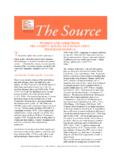Transcription of THE USE OF CRIMINAL HISTORY RECORDS IN COLLEGE …
1 THE USE OF CRIMINAL . HISTORY RECORDS IN. COLLEGE ADMISSIONS RECONSIDERED. THE USE OF CRIMINAL . HISTORY RECORDS IN. COLLEGE ADMISSIONS. RECONSIDERED. Acknowledgements This report was written by staff of the Center for Community Alternatives (CCA), Marsha Weissman, , Executive Director, Alan Rosenthal, Esq. and Patricia Warth, Esq. Co-Directors of Justice Strategies, Elaine Wolf, , Research Director, and Michael Messina-Yauchzy, , Research Associate, with editorial assistance from Loren Siegel. The National HIRE Network of the Legal Action Center and its Director, Roberta Meyers-Peeples, were instrumental in identifying individuals whose stories put a human face to the issues addressed in this paper.
2 Jeff Van Buren, Lisa Bailey, and Christine Abat . helped in the proofreading of the report and Karen Jones provided production assistance. We also wish to convey our appreciation to the American Association of Collegiate Registrars and Admissions Officers and particularly Barmak Nassirian, Associate Executive Director and Lisa Rosenberg, Associate Director, Research, for their considerable assistance with the survey. Special thanks to the many men and women who were willing to share their stories about their experiences applying to COLLEGE . We have highlighted but a few of the accounts of difficulties faced by people with CRIMINAL RECORDS in applying to COLLEGE . These narratives of hurdles and successes are what animate this report.
3 The Center for Community Alternatives is grateful to the Fulfilling the Dream Fund for its support of this project. The Center for Community Alternatives (CCA) promotes reintegrative justice and a reduced reliance on incarceration through advocacy, services and public policy development in pursuit of civil and human rights. For additional copies of this report visit: Table of Contents i EXECUTIVE SUMMARY. 2 I. Introduction 5 II. COLLEGE Campuses and Public Safety Concerns 7 III. Findings from the National Survey of Screening and Use of a CRIMINAL HISTORY in the COLLEGE Admissions Process 8 1. How widespread is the collection and use of CJI and how do colleges collect this information?
4 13 2. Do the colleges and universities that collect and use CJI have special procedures for evaluating whether or not to admit students with CRIMINAL RECORDS ? 17 3. How does an applicant's CRIMINAL record affect his or her admission? 20 4. What post-enrollment services or conditions are offered to or required of students with CRIMINAL RECORDS ? 22 IV. Closing Doors to Higher Education: The Impact of the CRIMINAL Justice System 22 1. Expansive Reach of the CRIMINAL Justice System 25 2. The Racial Impact of Using CRIMINAL RECORDS in Admissions Screening 27 3. Challenges in Interpreting CRIMINAL RECORDS and Identifying Inaccurate Information 29 V. Higher Education and Promotion of Public Safety 31 VI.
5 Recommendations for Reintegrative Justice: Making COLLEGE Accessible to People with CRIMINAL RECORDS 32 Recommendation 33 Secondary Recommendations 42 VII. Conclusion Executive Summary This report reviews findings from a first-of-its-kind survey conducted by the Center for Community Alternatives in collaboration with the American Association of Collegiate Registrars and Admissions Officers (AACRAO). that explores the use of CRIMINAL HISTORY screening in COLLEGE admissions procedures. A 59-question survey was administered electronically between September 30 and October 29, 2009 through AACRAO's network of 3,248. member institutions in the United States. In all, 273 institutions responded to the survey.
6 The survey helped inform the recommendations contained in this report. Key Findings A majority (66%) of the responding colleges collect CRIMINAL justice information, although not all of them consider it in their admissions process. Private schools and four-year schools are more likely to collect and use such information than their public and two-year counterparts. A sizable minority (38%) of the responding schools does not collect or use CRIMINAL justice information and those schools do not report that their campuses are less safe as a result. Self-disclosure through the COLLEGE application or in some cases the Common Application is the most typical way that colleges and universities collect the information.
7 A small minority of schools conduct CRIMINAL background checks on some applicants, usually through contracting with a private company. Most schools that collect and use CRIMINAL justice information have adopted additional steps in their admissions decision process, the most common of which is consulting with academic deans and campus security personnel. Special requirements such as submitting a letter of explanation or a letter from a corrections official and completing probation or parole are common. Less than half of the schools that collect and use CRIMINAL justice information have written policies in place, and only 40 percent train staff on how to interpret such information.
8 A broad array of convictions are viewed as negative factors in the context of admissions decision-making, including drug and alcohol convictions, misdemeanor convictions, and youthful offender adjudications. If it is discovered that an applicant has failed to disclose a CRIMINAL record there is an increased likelihood that the applicant will be denied admission or have their admission offer rescinded. A slight majority of schools that collect information provides support or supervision for admitted students who have CRIMINAL RECORDS , with more emphasis on supervision rather than supportive services. i Discussion The collection and use of CRIMINAL justice information (CJI).
9 By colleges and universities is problematic for a number of reasons. No link has been established between having a CRIMINAL record and posing a risk to campus safety. While COLLEGE campuses are not immune from crime, the data show that they are remarkably safe places compared to the community-at-large. This is particularly true for serious crimes that involve personal violence. Violent crime on campus is rare, and the few COLLEGE students who are victims of such crimes are mostly victimized off-campus by strangers. The Virginia Tech incident, a tragic but aberrational event, was committed by a student who did not have a CRIMINAL record. Our argument for eliminating the collection and use of CJI in admissions decisions is in large part based on the absence of any empirical evidence showing that students with CRIMINAL RECORDS pose a safety risk on campus.
10 Having a CRIMINAL record is not an unusual characteristic in America today. There has been a dramatic increase in the reach of CRIMINAL sanctions over the past three decades. As a result, by year end 2008 more than 92 million Americans had a CRIMINAL HISTORY record (arrest and/or conviction) on file in the state repositories, and more than million people were in jails and prisons, giving the the highest incarceration rate in the world. These high numbers are largely driven by the phenomenon of overcriminalization classifying an ever-widening range of behaviors as CRIMINAL . Misdemeanor cases, many of them involving petty offenses like under-age drinking, have doubled in the past thirty years.






